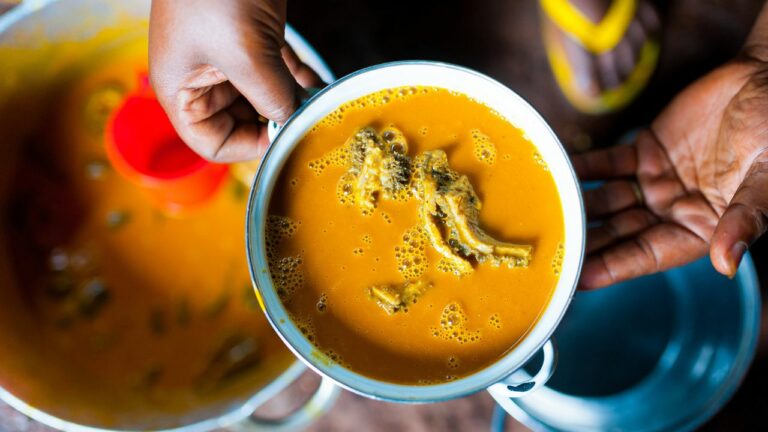Introduction: What is Cameroonian cuisine?
Cameroonian cuisine is a fusion of African, European, and Middle Eastern influences, reflecting the country’s diverse history and geography. The cuisine is characterized by the use of local ingredients such as cassava, plantains, yams, peanuts, and palm oil. Meat, fish, and poultry are also commonly used in Cameroonian dishes, often cooked in stews and soups with a variety of spices and herbs.
Traditional ingredients used in Cameroonian dishes
Cameroonian cuisine makes use of many traditional ingredients, some of which have been staples in the region for centuries. Cassava, for example, is a root vegetable that is used to make fufu, a starchy side dish that accompanies many meals. Plantains, another staple in the region, are often fried or roasted and served as a side dish or snack. Other common ingredients include yams, beans, peanuts, and a variety of leafy greens. Herbs and spices such as ginger, garlic, and chili peppers are also commonly used in Cameroonian dishes to add flavor and heat.
Regional variations in Cameroonian cuisine
Cameroonian cuisine varies by region, with different regions having their own unique dishes and cooking styles. In the north, for example, millet and sorghum are commonly used to make porridge, while in the south, rice and plantains are more popular. Coastal regions, meanwhile, make use of seafood in their dishes, with fish and crab being common ingredients. The Bamileke people, who live in the west, are known for their use of spices and herbs in their cooking, while the Bamiléké people in the east often use cornmeal to make fufu.
Popular dishes in Cameroonian cuisine
Some of the most popular dishes in Cameroonian cuisine include Ndolé, a stew made with bitterleaf greens and peanuts; Suya, a spicy kebab made with beef or chicken; and Eru, a soup made with a variety of leafy greens and meat or fish. Other popular dishes include Achu, a starchy side dish made with pounded cocoyam; Koki, a steamed bean pudding; and Mbongo Tchobi, a spicy fish stew.
Exploring the history behind Cameroonian cuisine
Cameroonian cuisine has a rich history that reflects the country’s varied cultural influences. The cuisine has been influenced by European colonialism, the Arab slave trade, and the migration of different ethnic groups within the region. Many of the dishes in Cameroonian cuisine have their roots in traditional cooking methods and ingredients that have been passed down through generations.
Are there any signature dishes in Cameroonian cuisine?
While there are many popular dishes in Cameroonian cuisine, there is no one signature dish that is universally recognized as representative of the cuisine. Instead, the cuisine is characterized by its diversity and the use of local ingredients and cooking techniques. However, some dishes, such as Ndolé, are widely recognized as emblematic of Cameroonian cuisine.
How to cook Cameroonian dishes at home
Cooking Cameroonian dishes at home is relatively easy, as many of the traditional ingredients can be found at local markets or specialty stores. Some popular ingredients to have on hand include plantains, cassava, yams, and peanuts. Recipes for popular dishes like Ndolé and Eru can be found online, as well as in cookbooks dedicated to African cuisine.
Conclusion: The future of Cameroonian cuisine
As Cameroon continues to modernize and globalize, its cuisine is likely to evolve and change. However, the core elements of the cuisine, such as the use of local ingredients and traditional cooking methods, are likely to remain. With more attention being given to African cuisine around the world, Cameroonian cuisine is poised to gain greater recognition and popularity in the years to come.

